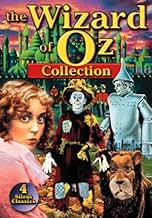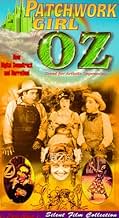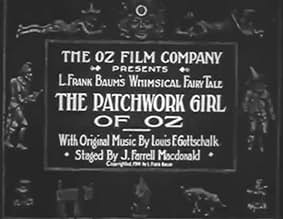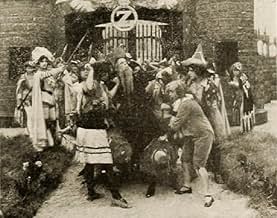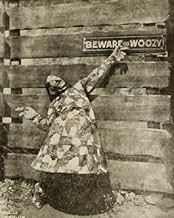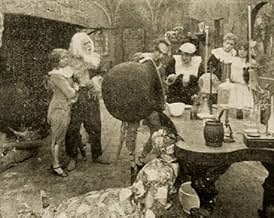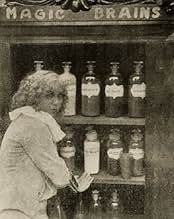अपनी भाषा में प्लॉट जोड़ेंOjo and Unc Nunkie are out of food, so they decide to journey to the Emerald City where they will never starve.Ojo and Unc Nunkie are out of food, so they decide to journey to the Emerald City where they will never starve.Ojo and Unc Nunkie are out of food, so they decide to journey to the Emerald City where they will never starve.
Leontine Dranet
- Margolotte, his wife, who makes the Patchwork Girl
- (as Haras Dranet)
Richard Rosson
- Danx, a Noble Munchkin
- (as Dick Rosson)
Bert Glennon
- The Scarecrow
- (as Herbert Glennon)
Hal Roach
- The Cowardly Lion
- (as Al Roach)
- …
Dave Anderson
- The Hungry Tiger
- (as Andy Anderson)
Pierre Couderc
- Scraps, the Patchwork Girl
- (as The Marvelous Couderc)
फ़ीचर्ड समीक्षाएं
As a child, The Patchwork Girl of Oz was my favorite Oz book. This silent film version is a charming look at how Oz was envisioned by it's creator--L. Frank Baum produced the film. The story however does stray from the book and some of the scenes are a bit disjointed. Motion pictures were in their infancy in 1914--most films were stagebound dramas, so to see a fantasy film from this period is unique.
The Patchwork Girl or "Scraps" is played by French acrobat Pierre Couderc. The part where Scraps catches the eye of the Scarecrow is very amusing. Also, the Yoop character is a forerunner to the Winged Monkeys who terrorized Judy Garland 25 years later.
In the video version I saw, the pivotal scene where Scraps is brought to life and tips over the Liquid of Petrification, is missing or destroyed--but the rest of the film is intact however.
The Patchwork Girl or "Scraps" is played by French acrobat Pierre Couderc. The part where Scraps catches the eye of the Scarecrow is very amusing. Also, the Yoop character is a forerunner to the Winged Monkeys who terrorized Judy Garland 25 years later.
In the video version I saw, the pivotal scene where Scraps is brought to life and tips over the Liquid of Petrification, is missing or destroyed--but the rest of the film is intact however.
L. Frank Baum himself produced and wrote this adaptation of his own Oz book, a full quarter century before Judy Garland strolled the yellow brick road. What survives is an intriguing artifact from cinema's infancy, antiquated in style and naive in sentiment, but compensating with plenty of charm for what it lacks in sophistication. The influence of theater can still be seen in the histrionic acting and static camera set-ups, but the affection Baum lavished on his creations (munchkins, magicians, 'hoppers', the 'woozy') is clearly evident, even today. His fertile imagination, reinforced by some clever (if primitive) camera tricks, makes this an enchanting fantasy with more than merely academic interest for students of early film history.
The enjoyable story and characters in "The Patchwork Girl of Oz" makes it a fun movie to watch, and it is also pretty resourceful for its era. It does have a lot of rough edges and shows some signs of age, but its energy and creativity more than make up for those. As with all of the Oz features made by L. Frank Baum's own studio, it shows his influence in the way that the fantasy world of Oz is brought to life with enthusiasm.
As with most of Baum's Oz stories, it has plenty of oddball characters and offbeat developments. A couple of odd casting choices add to the curious feel, with Pierre Couderc making Scraps look much like a male, and Violet Macmillan making Ojo seem more like a young girl. But they and the rest of the cast give their characters plenty of life, which really is more significant in a movie like this. As in the other Oz movies in the series, Fred Woodward also gets to perform a number of his costumed animal characters.
The story is one of Baum's most creative ones, telling a complex story in which the agendas and motivations of many different characters come into conflict. This adaptation is imaginative in using a lot of different techniques to reproduce the look of the characters, the magical events, and the hectic activity.
Much of it works rather well, and all of it represents a very good attempt for its time. Very few film-makers of the era ever tried to make a full-length picture out of such challenging fantasy material, and even if it has a fair number of rough edges, it remains a worthwhile and entertaining effort.
As with most of Baum's Oz stories, it has plenty of oddball characters and offbeat developments. A couple of odd casting choices add to the curious feel, with Pierre Couderc making Scraps look much like a male, and Violet Macmillan making Ojo seem more like a young girl. But they and the rest of the cast give their characters plenty of life, which really is more significant in a movie like this. As in the other Oz movies in the series, Fred Woodward also gets to perform a number of his costumed animal characters.
The story is one of Baum's most creative ones, telling a complex story in which the agendas and motivations of many different characters come into conflict. This adaptation is imaginative in using a lot of different techniques to reproduce the look of the characters, the magical events, and the hectic activity.
Much of it works rather well, and all of it represents a very good attempt for its time. Very few film-makers of the era ever tried to make a full-length picture out of such challenging fantasy material, and even if it has a fair number of rough edges, it remains a worthwhile and entertaining effort.
A young munchkin named Ojo (played by Violet MacMillan) and her Unc Nunkie decide to set out in search of a better life in the Emerald City of Oz. Along the way, they meet and befriend a magician and his family. The magician has long been at work on perfecting a magic powder of life, his wife having created a patchwork servant girl whom they hope to bring to life. Things go awry when the newly awakened patchwork girl accidentally spills a petrification fluid upon the Magician's wife and his future son in-law as well as Ojo's Unc Nunkie. Now our heroes (the Patchwork Girl, Ojo, the Magician and his daughter) must combine forces in search of the different, rare and hard to obtain ingredients necessary for a spell to undo the petrification process. Many unusual adventures, magical as only the world of Oz can be, await.
This delightful flight of fancy provides viewers with a fun escape from reality. The actors and actresses breathe such a wonderfully vibrant energy into their lively performances that they prove quite a joy to watch. Basically this starts off as a series of individual stories focused on a wide number of colorful characters. By the film's end however, all these different characters and their individual stories seem to merge together into one near epic tale. Of the three 1914 Oz film produced in part by L. Frank Baum himself, this one is clearly the best and most complete adventure story.
This delightful flight of fancy provides viewers with a fun escape from reality. The actors and actresses breathe such a wonderfully vibrant energy into their lively performances that they prove quite a joy to watch. Basically this starts off as a series of individual stories focused on a wide number of colorful characters. By the film's end however, all these different characters and their individual stories seem to merge together into one near epic tale. Of the three 1914 Oz film produced in part by L. Frank Baum himself, this one is clearly the best and most complete adventure story.
The most famous movie adaptation of a novel by L. Frank Baum entails Toto, a tornado, ruby slippers and a yellow brick road. Well, it turns out that Victor Fleming's 1939 adaptation was not the first. An earlier screen version of "The Wizard of Oz" was a 1925 loose adaptation of the story, notable for casting Oliver Hardy as the Tin Woodsman.
And then there were the adaptations in which Baum himself participated. He founded the Oz Film Manufacturing Company and made some movie versions of his novels. These aren't the most sophisticated adaptations but are worth seeing as a look into early cinema. "The Patchwork Girl of Oz" features things like people getting turned into statues (and one of them getting shrunken down so that a woman can carry him). Yeah, Baum came up with some wacky stuff.
One interesting thing about this movie is that the lion is played by none other than Hal Roach, best known as the producer of Laurel & Hardy's movies. It appears that only Stan Laurel didn't get to go to Oz on the silver screen. Of course, I can't picture him in Oz without imagining that he would have turned everything upside down. In other words, it would have been another fine mess that he'd gotten himself into!
Anyway, this movie is worth seeing. I wonder what Baum would have thought of the most famous adaptation of his work, had he lived to see it.
And then there were the adaptations in which Baum himself participated. He founded the Oz Film Manufacturing Company and made some movie versions of his novels. These aren't the most sophisticated adaptations but are worth seeing as a look into early cinema. "The Patchwork Girl of Oz" features things like people getting turned into statues (and one of them getting shrunken down so that a woman can carry him). Yeah, Baum came up with some wacky stuff.
One interesting thing about this movie is that the lion is played by none other than Hal Roach, best known as the producer of Laurel & Hardy's movies. It appears that only Stan Laurel didn't get to go to Oz on the silver screen. Of course, I can't picture him in Oz without imagining that he would have turned everything upside down. In other words, it would have been another fine mess that he'd gotten himself into!
Anyway, this movie is worth seeing. I wonder what Baum would have thought of the most famous adaptation of his work, had he lived to see it.
क्या आपको पता है
- ट्रिवियाHarold Lloyd and Hal Roach, who both have minor roles in this film, met on this set in San Diego. Roach was impressed by Lloyd's energy and sought him out when he formed his production company The Rolin Film Company in July 1914 after receiving a small inheritance. Although their association was stormy, their association was ultimately one of the most successful in silent film history.
- गूफ़The character of Ojo is stated several times to be a boy, but is referred to as a girl in one of the dialogue caption cards.
- कनेक्शनFeatured in American Masters: Harold Lloyd: The Third Genius (1989)
टॉप पसंद
रेटिंग देने के लिए साइन-इन करें और वैयक्तिकृत सुझावों के लिए वॉचलिस्ट करें
- How long is The Patchwork Girl of Oz?Alexa द्वारा संचालित
विवरण
- चलने की अवधि
- 1 घं 21 मि(81 min)
- रंग
- ध्वनि मिश्रण
- पक्ष अनुपात
- 1.33 : 1
इस पेज में योगदान दें
किसी बदलाव का सुझाव दें या अनुपलब्ध कॉन्टेंट जोड़ें

